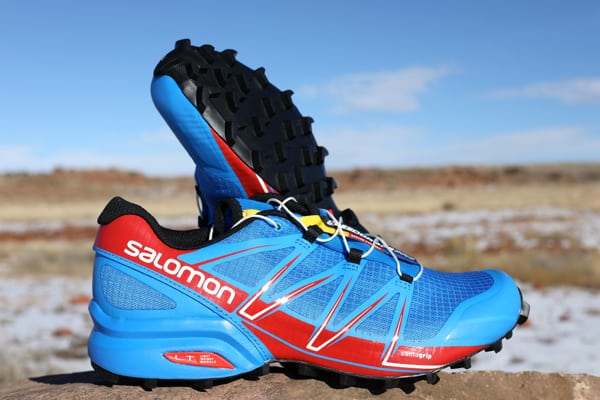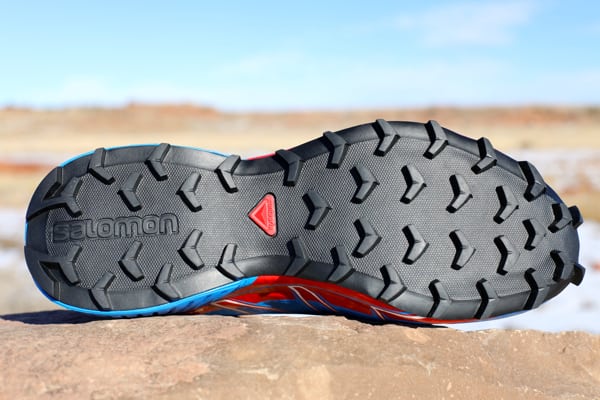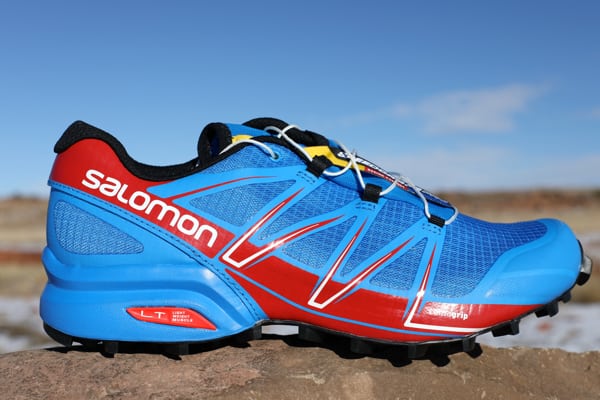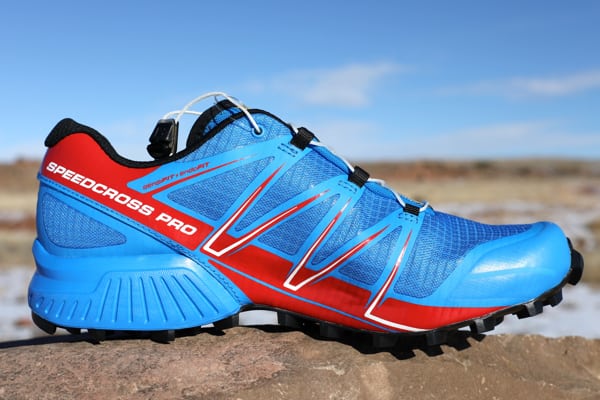For the latest on the Speedcross family, check out our Salomon Speedcross 6 review.
Our Favorite Trail Running Shoes
To learn about our current favorite trail running shoes, check out our Best Trail Running Shoes article.
Salomon Speedcross Pro Review
[Editor’s Note: This review was written by guest contributor Kyle Emery.]
When I walk into a running store, I like to compare all the shoes on display to types of cars. I see the flashy, brightly colored cross-country spikes as Indy cars, the big, heavily cushioned shoes are SUVs, and more. When I laid eyes on the Salomon Speedcross Pro ($150), the very first thing that came to my mind was the big knobby wheels of an off-road Jeep. The 11.5-ounce men’s size 9/9.7-ounce women’s size 7 shoes, with their 10mm heel-toe drop and 6mm lugs, were just asking to be let loose in the mud! I was happy to oblige.

The Salomon Speedcross Pro.
Salomon Speedcross Pro Outsole
Because the most distinctive feature of this trail running shoe is the big, 1/4-inch (6mm) chevron lugs that cover the entirety of the outsole, I begin here. These lugs and the rest of the outsole appear to be made from a single piece of soft rubber, which Salomon calls Premium Wet Traction Contagrip. Contagrip is a material technology that Salomon pioneered back in 1994 and has continued to refine throughout the years. Its main purpose is to provide grip and durability in difficult conditions on all kinds of terrain.
When I first got this shoe, I was definitely concerned that the softer Premium Wet Traction material would quickly wear down and make this shoe unwearable after a relatively short amount of time. To my pleasant surprise, after a few months of heavy use, I can’t see or feel any wear on the outsole. However, I did not use these shoes on pavement at all. I have a feeling that the soft rubber lugs would wear down quickly if these shoes were taken on a road at any point in its life.
The grip of this shoe is outstanding in every condition and terrain I took it through. The M+S (Mud and Snow) lug design of the shoe worked remarkably well in all soft/muddy/snowy conditions I ran in. The shoe provided enough traction for me to bomb down muddy trails and to climb up snowy trails with complete abandon!
The outsole rides up over the toe of the shoe, giving the impression of good protection for your toes. Unfortunately, after stubbing my toes a few times on stray rocks and roots, I found out that the soft rubber outsole has no reinforcement behind it and every stubbed toe is felt with painful detail.

The Salomon Speedcross Pro’s outsole.
Salomon Speedcross Pro Upper
The upper is composed primarily of a dense Anti Debris Mesh with a water-resistant material welded to it, especially around the base of the upper where it meets the outsole, creating what Salomon calls its Mud Guard. In my opinion, Salomon always seems to do well with creating new materials, and this Anti Debris Mesh works incredibly well. I took this shoe through dust, snow, dirt, water, mud… you name it! Through it all I didn’t get any dirt, grime, or snow on my toes or forefoot. That was a huge win on longer runs! In the past, I have been susceptible to blisters on my toes whenever my feet get dirty. Luckily, since the Anti Debris Mesh kept dirt and debris out of my forefoot area, I did not develop blisters or hotspots even after running through muddy singletrack trails.
The tight mesh and Mud Guard in the upper are great at keeping things out, but it does limit the shoe’s breathability a little bit. On the few occasions when I did dunk my entire foot into a puddle, it would take a couple of miles before my feet started to dry out. Similarly, on hot days when my feet would sweat, my running socks would be relatively damp by the time I finished running. However, outside of these more extreme test conditions, the breathability of the shoe was never a major issue for me.
The Endofit tongue design is unique because the lower portion is made of a stretchy fabric that wraps around your midfoot. It gave the shoe a ‘snug’ feeling, but it didn’t seem to really do much for me out on the trail. In rough terrain I still noticed my foot would slip inside the shoe a little bit, as with any other shoe, and I still had to occasionally readjust the tongue during my runs.
Okay, now for the negative part: the Quicklace system. Some of you reading this might love the Quicklace, but I have never been a huge fan of it. The single biggest issue I have with it is the comfort. The Quicklace system is made to be a quick-and-easy mechanism that cinches the laces down in one pull. However, if I just pull it tight and go, I get a very uncomfortable pressure on the top of my foot. To fix this, I have to fuss with the laces to tighten them around my foot more comfortably. By the time I have the Quicklaces cinched down comfortably and the slack tucked into the tongue pouch, it ends up taking me more time than just tying a normal pair of laces. For longer distances I found the Quicklace would loosen over time and I would need to tighten and readjust midway. I eventually grew used to this minor inconvenience and I just lived with it, but if a person wanted to, they could cut the Quicklaces off and put in normal shoelaces.

The Salomon Speedcross Pro’s lateral upper.
Salomon Speedcross Pro Midsole
The Speedcross Pro midsole has a more complicated construction than your typical running shoe. While most shoes will have a midsole that is either a molded EVA (Ethylene-Vinyl Acetate) or an injected EVA, Salomon used both of these types of construction methods to create the midsole of the Speedcross Pro. While the technical aspects of molded and injected EVA can vary based on the specific compounds and manufacturing methods used, it seems like Salomon tried to combine the generally softer, more cushioned aspects of injected EVA with the generally denser and more durable molded EVA.
The interesting combination of technologies created a differing feeling depending on the conditions. In mud and snow, the shoe seemed to have just the right amount of cushioning versus support for me. However, the midsole did not seem to provide enough protection from the lugs themselves on harder surfaces. I was always hesitant to run in these shoes for more than 90 minutes on hard terrain because the balls of my feet would start to hurt. The midsole design also leaves out the protection of a rockplate. The combination of a mediocre-feeling midsole with the lack of a rockplate tended to make me feel a little unprotected in technical terrain. My feet felt the consequences of every rock and root I stepped on during runs and casual hikes.

The Salomon Speedcross Pro’s medial upper.
Overall Impressions
I took this shoe out in many different conditions and one thing was made very obvious: The softer the terrain, the better this shoe performs. I took these guys out in on steep singletrack trails in both muddy and snowy conditions, and I was able to push the pace going up and down these hills without any traction issues! I’m not a fan of this shoe in dry trail conditions or on technical trails for a variety of reasons: the heavier weight made this shoe feel overbuilt, the lack of protection in the midsole would occasionally hurt my feet during longer runs or on hard surfaces, and the total stack height from the shoe’s offset and lugs would often make me feel unbalanced when I was running on roots or rocks. However, if you spend significant time running in mud and snow, this soft-conditions specialist may suit you.
Call for Comments (from Meghan)
- Have you run in the Salomon Speedcross Pro? What is your overall impression of the shoe?
- On what types of surfaces and in what conditions have you found the Salomon Speedcross Pro to perform the best? Does it feel reliable underfoot in soft and slippy conditions?
- How does the Salomon Speedcross Pro feel to you on hard surfaces and technical trail conditions?
[Editor’s Note: If you’re affiliated (i.e., an employee, ambassador, etc.) with a shoe brand, please share your relation in each of your comments on this article. Thanks!]
